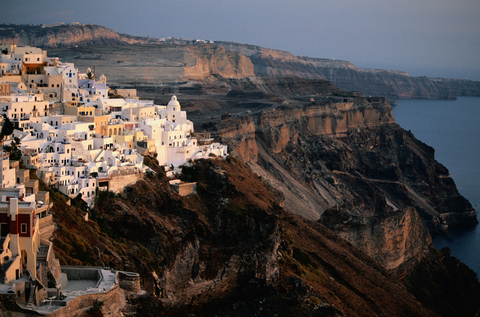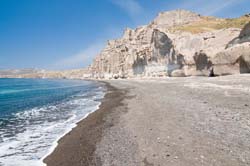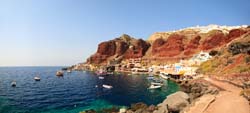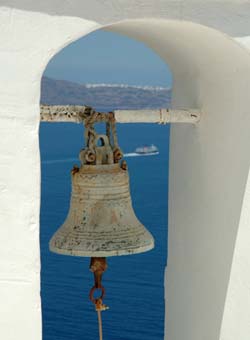
Take a look at our list of 5 star hotels in Greece and experience a holiday in luxury and style ...
You need to upgrade your Flash Player
Please visit Adobe's Flash Player site to upgrade the most recent version.
Thank you.
If you are having issues with installing Adobe Flash Player, please make sure that all "pop-up killer" applications are turned off and you reinstall
the Adobe player.
Santorini island

Information about Santorini
general information
- Santorini belongs to the Cyclades islands cluster
- Santorini covers around 74 square km
- Distance from Piraeus is 52 nautical miles
- Inhabitants approximately 13,450
- Capital of Santorini is Fira
- Connection with Athens via the port of Piraeus and Rafina
- Connection by ferry with Paros, Naxos and Ios
- Daily connection with Athens International Airport
- Charter flights from European countries and the US during summer

 Santorini is perhaps the most famous Greek island. It belongs to the group of Cyclades islands, located towards the south.
Santorini is perhaps the most famous Greek island. It belongs to the group of Cyclades islands, located towards the south. The island has been widely known because of its unique beauty and breathtaking view. But that is only part of the islands charm. Santorini is a vivid example of nature's bursts.
Santorini differs from the other islands in the group thanks to its geological morphology, the result of action by a volcano now dormant. The landscape of the western side of the island, where towering cliffs crown by tiny and blindingly-white houses plunge straight into the depths of the sea.
 Ancient Thira is a site of great archaeological interest which was occupied by Phoenicians, Dorians, Romans and Byzantines. The site of Akrotiri has yielded the remains of Minoan city destroyed around 1500 BC by an eruption of the volcano on Thira. In effect, this is a prehistoric version of Pompeii buried beneath volcanic ash, with two and three-storeyed houses, with squares, shops, workshops and so on.
Ancient Thira is a site of great archaeological interest which was occupied by Phoenicians, Dorians, Romans and Byzantines. The site of Akrotiri has yielded the remains of Minoan city destroyed around 1500 BC by an eruption of the volcano on Thira. In effect, this is a prehistoric version of Pompeii buried beneath volcanic ash, with two and three-storeyed houses, with squares, shops, workshops and so on. Today visitors gather to admire the calderas of Fira, Firostefani, Imerovigli and Ia and the amazing sunset that puts the entire sky on fire. We have put together a selection of hotels, studios and apartments on the islands which we have carefully selected during our trips to the island and which cover a variety of accommodation from a four star hotel to a comfortable studio with cooking facilities.
 island tour
island tour The steep coastline of the west is countered by the vast beaches of the east side, some of them sandy and others with pebbles.
From the landing-place, Skala, we can climb up to Fira, the capital, on foot or on donkey-back. There is a funicular railway for those who wish to avoid the hundreds of steps.
Fira is very attractive, with winding narrow streets, arcades and a quarter where the Catholic nobility once dwelt. There is a most important Museum, with prehistoric finds (mostly pottery), a large collection of vases dating from the 7th and 6th centuries BC (including the pieces known as 'Thera ware'), a few Archaic and Classical pieces, and some Hellenistic and Roman sculptures and portraits.
 There is a superb view out from Fira to the Kamenes, the two islets of black stone created by the volcano. The islets can be visited by launch.
There is a superb view out from Fira to the Kamenes, the two islets of black stone created by the volcano. The islets can be visited by launch. Ancient Thira is a site of great archaeological interest which was occupied by Phoenicians, Dorians, Romans and Byzantines. Down the centre of the city runs the Sacred Way. The buildings include groups of houses, market-places, baths, theaters, sanctuaries, the residence of Ptolemy Euergetes, tombs of the Archaic and classical periods and Early Christians remains. On the surrounding rocks the names of the god Apollo and of men and boys are inscribed in the ancient alphabet of Thira.
The site of Akrotiri has yielded the remains of Minoan city destroyed around 1500 BC by an eruption of the volcano on Thira. In effect, this is a prehistoric version of Pompeii buried beneath volcanic ash, with two and three-storeyed houses, with squares, shops, workshops and so on. Among the finds from the houses were marvelous murals (on display in the National Archaeological Museum, Athens), vases and everyday utensils. On the highest peak of Santorini is a monastery of the Prophet Elijah (Profitis Ilias), where there is a picturesque religious feast on 20 July each year.
Most tourists gather nowdays at the four calderas of Fira , Firostefani , Imerovigli and Ia , as well as the beaches of Kamari and Perissa with the gray-black pebbles. There are many hotels and studios in these areas, as well as luxury hotels, however, it is still hard to find a place to stay even in early May, since thousands of tourists gather each year to admire the unique beauty of the island.
Travel in Cyclades
- Cyclades islands
- All Cyclades islands
- Amorgos island
- Anafi island
- Andros island
- Antiparos island
- Delos island
- Donoussa island
- Folegandros island
- Heraklia island
- Ios island
- Kea (Tzia) island
- Keros island
- Kimolos island
- Koufonissia islands
- Kythnos island
- Milos island
- Mykonos island
- Naxos island
- Paros island
- Santorini island
- Schinoussa island
- Serifos island
- Sifnos island
- Sikinos island
- Syros island
- Tinos island






